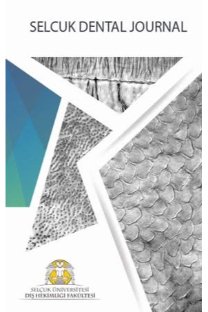Toplumumuzda diş ipi kullanma alışkanlığı
The frequency of using dental floss among our society
___
- 1. Rose LF, Mealey B, Genco R, Cohen DW. Periodontics: Medicine, Surgery and Implants. MOSBY, p. 99-116, 2004.
- 2. Lang NP, Cumming BR, Löe H. Toothbrushing frequency as it relates to plaque development and gingival health. J Periodontol 1973; 44: 396-405.
- 3. Williams DM, Hughes FI, Odell EW, Farthing PM. Pathology of Periodontal Disease. Microbial factors in the pathogenesis of periodontal disease. New York: Oxford University Press, p.40-65, 1992.
- 4. Dörter C, Koray F, Yaman BC, Tiryaki M, Erdilek D, Efes B, Gömeç Y. Plaque Removal Efficacy of Tooth Wipe and Antiplaque Effect of a Xylitol Containing Chewing Gum. CONSEURO Meeting 2006, ROMA.
- 5. Graves RC, Disney JA, Stamm JW. Comparative effectiveness of flossing and brushing in reducing interproximal bleeding. J Periodontol 1989; 60:243-7.
- 6. Newman MG, Takei H, Carranza FA. Carranzas Clinical Periodontology. W.B. Saunders Company, 2002.
- 7. Echeverria JJ, Sanz M, Rylander H: Mechanical supragingival plaque control.In: Lindhe J, Karring T, Lang NP eds: Clinical Periodontology and Implant Dentistry. Paris: Blackwell, p. 449-59, 2003.
- 8. Graves RC, Disney JA, Stamm JW. Comparative effectiveness of flossing and brushing in reducing interproximal bleeding. J Periodontol 1989; 60:243-7.
- 9. Farsi JM, Farghaly MM, Farsi N. Oral health knowledge, attitude and behaviour among Saudi school students in Jeddah city. J Dent 2004; 32: 47-53.
- 10. Axelsson P, Paulander J, Svardstrom G, Tollskog G, Nordensten S. Integrated caries prevention: effect of a needs-related preventive program on dental caries in children. County of Varmland, Sweden: results after 12 years. Caries Res 1993; 27 suppl: 183-194.
- 11. Kuusela S, Honkala E, Kannas L, Tynjälä L, Wold B. Oral hygiene Habits of 11 year old schoolchildren in 22 European countries and Canada in 1993/1994. J Dent Res 1997; 9: 1602 9.
- 12. Astrom AN. Stability of oral health-related behaviour in a Norwegian cohort between the ages of 15 and 23 years. Community Dent Oral Epidemiol 2004; 32: 354-62.
- 13. Wong CH, Wade AB. A comparative study of effectiveness in plaque removal by Super Floss and waxed dental floss. J Clin Periodontol 1985; 12:788-95.
- ISSN: 1300-5170
- Yayın Aralığı: Yılda 3 Sayı
- Başlangıç: 1991
- Yayıncı: İsmail Marakoğlu
Betül GÜNEŞ, Hale AYDINBELGE ARI
Toplumumuzda diş ipi kullanma alışkanlığı
Hakan ARSLAN, Çağatay BARUTCİGİL, Duygu KÜRKLÜ, Hüseyin ERTAŞ
Zirkonya: Yapısı ve altyapı üretim tekniği
İki farklı porselen laminate veneer restorasyonun kenar uyumunun in-vitro olarak değerlendirilmesi+
MERAL ARSLAN MALKOÇ, Atiye Nilgün ÖZTÜRK, Şerife Tuba BÜYÜKÖZER, Bora ÖZTÜRK
Tooth shade assessment after lingual retainer application: A prospective clinical trial
Hasan Önder GÜMÜŞ, Faruk İzzet UÇAR, Hayriye ŞENTÜRK, Tancan UYSAL
Leyla B. AYRANCI, Hakan ARSLAN, H. Sinan TOPÇUOĞLU
In vitro evaluation of marginal leakage using various temporary filling materials
Ayçe ELDENİZ ÜNVERDİ, MAKBULE BİLGE AKBULUT, MEHMET BURAK GÜNEŞER
Obezitenin tükürük PH'sı, tamponlama kapasitesi ve diş çürüğü insidansı'na etkisi+
Abdulkadir ŞENGÜN, NAZMİYE DÖNMEZ, İsmet DURAN, H.Esra ÜLKER
